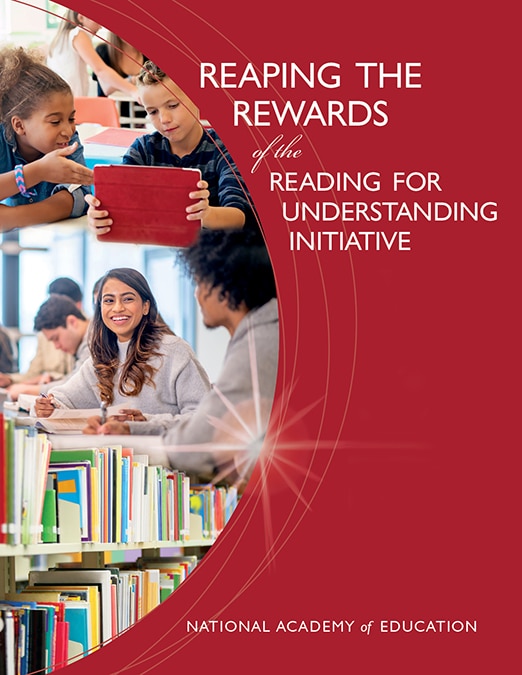Reaping the Rewards of Reading for Understanding
The Reaping the Rewards of the Reading for Understanding Initiative report articulates findings and common themes concerning the nature and development, assessment, and the enactment of curriculum and instruction of reading comprehension. It synthesizes work both within and across the six research teams, reviewing over 200 scholarly articles from this substantial and unprecedented effort to determine what has been learned about understanding and improving reading comprehension. Key findings include: (a) the importance of emphasizing comprehension in pursuit of knowledge and insight; (b) redoubling our efforts to enhance language development, both oral and written, for students across the age-span; and (c) changing the culture of classrooms to emphasize collaboration, deep comprehension, critique, and the generative use of comprehension. Additionally, this project includes a paper that is a conceptual review of technology-related reading comprehension research, as well as research related to multimodal meaning-making (both digital and nondigital) and reading comprehension in out-of-school contexts, in order to highlight future directions for reading comprehension research that complement those indicated by the RfU teams.
Reaping the Rewards
of the
Reading for Understanding Initiative
Editors
P. David Pearson, University of California, Berkeley
Annemarie Sullivan Palincsar, University of Michigan
Gina Biancarosa, University of Oregon
Amy I. Berman, National Academy of Education
CONTENTS
 Front Matter
Front Matter
 Acknowledgements
Acknowledgements
 Executive Summary
Executive Summary
 1. Introduction to the Reading for Understanding Initiative
1. Introduction to the Reading for Understanding Initiative
Annemarie Sullivan Palincsar; P. David Pearson, Amy I. Berman, and Peter Afflerbach
APPENDIX 1-1 DESCRIPTION OF PROCEDURAL ELEMENTS FOR DEVELOPING THIS REPORT
 2. The Nature and Development of Reading for Understanding
2. The Nature and Development of Reading for Understanding
Gina N. Cervetti
 3. The Assessment of Reading for Understanding
3. The Assessment of Reading for Understanding
Panayiota Kendeou
APPENDIX 3-1 BRIEF REVIEWS OF READING FOR UNDERSTANDING ASSESSMENTS
 4. Teaching Reading for Understanding: Summarizing the Curriculum and Instruction Work of the Five Core Reading for Understanding Teams
4. Teaching Reading for Understanding: Summarizing the Curriculum and Instruction Work of the Five Core Reading for Understanding Teams
Gina Biancarosa, Peter Afflerbach, and P. David Pearson
APPENDIX 4-1 PUBLISHED MEASURES USED IN THE READING FOR UNDERSTANDING PORTFOLIO OF EFFICACY STUDIES REPRESENTED IN CHAPTER 4 AND 5
APPENDIX 4-2 DEMOGRAPHIC DATA FOR READING FOR UNDERSTANDING TEAMS’ RANDOMIZED CONTROLLED TRIALS
 5. Teaching Reading for Understanding: Synthesis and Reflections on the Curriculum and Instruction Portfolio
5. Teaching Reading for Understanding: Synthesis and Reflections on the Curriculum and Instruction Portfolio
Peter Afflerbach, Gina Biancarosa, Matthew Hurt, and P. David Pearson
 6. Taking Stock of the Reading for Understanding Initiative
6. Taking Stock of the Reading for Understanding Initiative
P. David Pearson, Annemarie Sullivan Palincsar, Peter Afflerbach, Gina N. Cervetti, Panayiota Kendeou, Gina Biancarosa, Jennifer Higgs, Miranda Fitzgerald, and Amy I. Berman
 Biographical Sketches of Steering Committee Members and Authors
Biographical Sketches of Steering Committee Members and Authors
Additional Resources:
New Media, New Literacies: Implications for Reading for Understanding
Miranda Fitzgerald, Jennifer Higgs, and Annemarie Sullivan Palincsar
Steering Committee Members
Contact
- Annemarie Sullivan Palincsar (Co-chair)
University of Michigan
- Donald Compton
Florida State University
- Kenji Hakuta
Stanford University
- Laura Justice
The Ohio State University
- John Sabatini
The University of Memphis
- Sharon Vaughn
The University of Texas at Austin
- P. David Pearson (Co-chair)
University of California, Berkeley - Susan Goldman
University of Illinois at Chicago - Glynda Hull
University of California, Berkeley - Christopher Lonigan
Florida State University - Catherine Snow
Harvard University and Strategic Education Research Partnership
Amy I. Berman, Deputy Director
This project and research reported here were supported by grant R305U160002 from the U.S. Department of Education’s Institute of Education Sciences (IES). The opinions expressed are those of the editors and authors and do not represent the views of IES.

